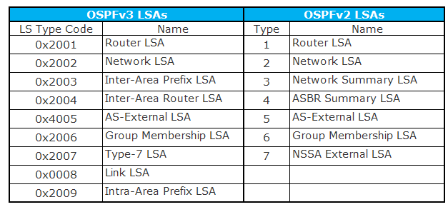What is OSPF? Watch the video to learn OSPF:
This article outlines few comparisons of OSPFv3 and OSPFv2 Routing Protocol. OSPFv3 has few similarities with that of IPv4 version i.e. OSPFv2 in some ways, like Packet Type, Interface Type, Neighbor Discovery Pattern, LSA flooding & aging.
OSPFv3 and v2 Differences:
>Protocol processing per-link, not per-subnet
>Removal of addressing semantics
>Addition of Flooding scope
>Explicit support for multiple instances per link
>Use of IPv6 link-local addresses
>Authentication method changes
>Packet format, LSA’s header format changes
>Handling of unknown LSA types
Protocol processing per-link, not per-subnet:
IPv6 uses the term “link” instead of “subnet” or “network” to define a medium used to communicate between nodes at the link layer. Multiple IP subnets can be assigned to a single link, and two nodes can communicate with each other even if they do not share a common IP subnet.
OSPfv3 Packet/Interface Type
| OSPFv3 Packet Type | OSPFv3 Interface Type |
| Type 1 – Hello | P2P |
| Type 2 – Database Description | P2MP |
| Type 3 – Link State Request | Broadcast |
| Type 4 – Link State Update | NBMA |
| Type 5 – Link State Acknowledgement | Virtual |
OSPFv3 Header Comparison
| Field | OSPFv3 | OSPFv2 |
| Header Size | 16 Bytes | 24 Bytes |
| Router & Area ID | 32 Bit | 32 Bit |
| Instance ID | Yes | No |
| Authentication | IP Sec | Interface Specific and Entire Area |
Note: In OSPFv3, Instance ID is a new field that is used to have multiple OSPF process’ instance per link. By default it is 0 and for any additional instance it is increased, instance ID has local link significance only. OSPFv3 routers will only become neighbors if the instanceIDs match. It is thus possible to have multiple routers on a broadcast domain and all run Ospfv3 but not all of them becoming neighbours.
OSPFv3 Hello Packet and Functioning

Note: Interface ID is a 32-bit number uniquely identify an interface, virtual link gets its own interface ID.
- As compared, OSPFv3 does not require a Network mask to form an adjacency formation. Adjacency is formed on the link local as v6 runs on per link instead of per subnet.
- OSPFv3 Option field is 24-bit as that of V2 8-bits
- Dead intervals field reduced to 16 bits from 32.
- Multicast Address
| Multicast Address | OSPFv3 | OSPFv2 |
| All-SPF Routers | FF02::5 | 224.0.0.5 |
| All-DR Routers | FF02::6 | 224.0.0.6 |
OSPFv3 LSA Types

- LSA Type or the function code matches the same LSA type as in OSPFv2
- Type 3 is now called inter-area-prefix-LSA
- Type 4 is now called inter-area-router-LSA
- Two new LSA type have been added (Link LSA and Intra-Area Prefix LSA)
Note: Intra-Area Prefix LSA is a new LSA in OSPFv3 and used in order to advertise one or more IPv6 prefixes. In OSPFv2 the intera-area prefix information was carried in the router and network LSA’s (Type 1 & 2).
Support for Multiple Instances Per Link:
Instance ID is a new field that is used to have multiple OSPF process instance per link. In order for 2 instances talk to each other they need to have the same instance ID. By default it is 0 and for any additionalinstance it is increased, Instance ID has local link significance only.
Authentication method changes:
OSPFv2 authentication is achieved by implementing a shared secret and MD5 HMAC supported as part of the OSPFv2 protocol. OSPFv3 does away its own support for authentication entirely, instead relying on the more flexible IPsec framework offered by IPv6.
Reference
Cisco IPv6 Knowledge Base Portal
OSPFv3 Address Families At-A-Glance
—Original Doc File from https://supportforums.cisco.com/docs/DOC-23905
More Related:



